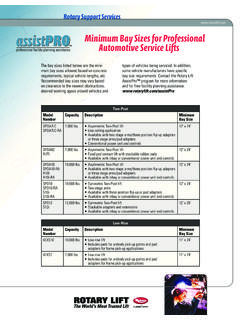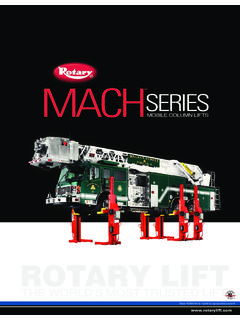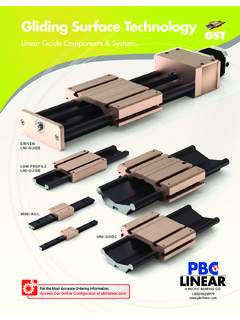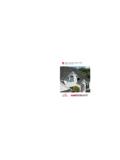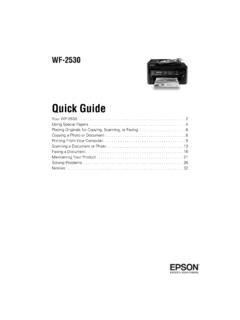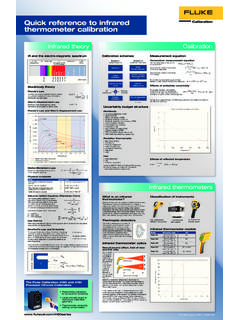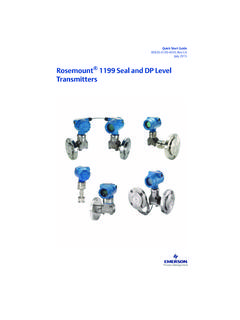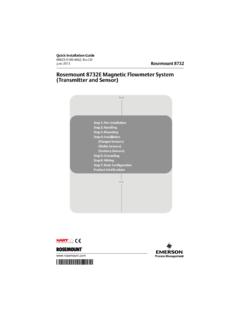Transcription of Surface Lift Identification Guide
1 Surface LiftIdentificationGuideSurface LiftIdentificationGuideEntire contents September 1999 by Rotary Lift. All rights 49-7-1 Rev. A 9/1/992 This Guide was developed for the purpose of identifying the different vintages of full rise Surface liftsmanufactured by Rotary since the mid model type is defined with a brief description including the distinguishing characteristics of thelift. Also included are pictographic representations of each model type which include dimensional Post Family of Lifts(See page 4 for column styles)SP lifts have hose and cables running across the lifts have the hoses and cables running lifts have the hoses and cables running overhead and the columns are rotated 300 towards , and SPOA82 models of lifts are rubber pad type frame contact series of lifts: Introduced in May 1976.
2 Columns were style A using 8 wide flange H beam with external carriage. This model used a base frame that was anchored to the floor and thecolumns were bolted to the base mounting series of lifts: Introduced in October 1980. There were two versions of this model. The firstversion (SP80 thru -3 and SP84 thru -7) used a base frame that was anchored to the floor and thecolumns were bolted to the base mounting plate. The second version introduced in June 1982 (SP80-4and above and SP84-8 and above), the columns were anchored directly to the floor. Both versions usedcolumn style B that were 3 pieces of formed C channel welded together with internal carriages used roller bearings, in July 1987 slider blocks were : SP84-15, 16, and 17 cables and hydraulic lines were run through a trench cut in the floor betweenthe columns.
3 The cover was a flat series of lifts: Introduced in February 1985. Columns were style B that anchored directly to thefloor. Early carriages used roller bearings, in July 1987 slider blocks were series of lifts: Introduced in April 1985. Basically the same as SP84-8 and above with theexception of column spacing and arm design. This model was designed specifically for smaller series of lifts: Introduced in July 1985. Columns were style B . There were 2 versions ofthis model. The first version includes through the -4 series. The lifts have columns that measure103 3/4" tall. The column extensions measure 42 3/8".
4 The second version includes -5 (December1987) and above. These columns measure 95 3/4" tall. The column extensions measure 50 3/8".NOTE: The overall height of the lift did not January 14, 1988 we began supplying arm restraints that were mounted to the outside of the arms forthe SP/SPO/SPOA84/94 series of series of lifts: Introduced in March 1989. First "Double S"formed columns. Column style C . First lifts with the single point latch May 1992 enhancements were made to the 88/98 series of lifts. Introduced JIC fittings on the hosesand changed the routing of the hoses to the inside web of the "Double S" formed (SPOA77) series of lifts: Introduced in March of 1991.
5 Columns were formed but not DoubleS design. Full length column eliminated the need for bolt on extensions. Asymmetric design achievedthrough use of offset front arms rather than rotated series of lifts: Introduced in January 1993. Column style C . First liftswith arm restraints mounted internally on the carriage end of the arm, that would automatically releasewhen lift was fully : Introduced in January 1993. Column style C , measuring 17 across the (also known as SPALC93): Introduced in January 1993. Low ceiling lift. Floor equalized andpiggyback hydraulic cylinders. Column style C.
6 SPO12: Introduced officially in March 1994. Column back measures 17 (inside measurement).Basically the same as the SPO15. Earlier lifts were identical, later series utilized a different carriage.(No gussets on the carriage and on the ends of the yoke). Column style C .SPO9/OA7/OA82/OA9 -100 series of lifts: Introduced in April 1995. The backs of these columnswere narrowed from 12" to 10" (inside measurement). Note: Other components were also revised at thesame time due to the column redesign. Column style C .SPO9/OA7/OA82/OA9 -200 series of lifts: Introduced in September 1996. Many common partsbetween the lifts, including the Columns, Carriages, and Baseplates.
7 First lifts with open gussets on thearms. Column style C .SPO18: Introduced in February 1997. Column style C measuring 17 across the -10 series of lifts: Introduced in March 1997. Column back measures 12 (insidemeasurement). Column style C .SPOA7LC: Introduced in July 1997. Low ceiling lift. Overhead equalized and piggyback hydrauliccylinders. Column style C .4135" SP70/74130 3/8" Standard SPOA84120 3/8" Narrow Bay SPOA84128" Standard SPOA84118" Narrow Bay SPOA84128" Standard SPOA8288120" Narrow Bay SPOA88134" Standard SPOA98128" Standard SPALC7128" Standard SP/SPO7120" Narrow Bay SP/SPO7134" Standard SP/SPO9(No Dash and -100 Series)128" Standard SPOA7/82120" Narrow Bay SPOA7134" Standard SPOA9(No Dash and -100 Series)131 3/8" Standard SPOA7/82123 3/8" Narrow Bay SPOA7137 3/8" Standard SPOA9(-200 Series)137 5/8" Standard SPO9(-200 Series)
8 137 3/8" Standard SPOA7LC129 3/8" Narrow Bay SPOA7LC128" Standard SP/SPO82/88134" Standard SP/SPO98128" Standard DCOA7/SPOA77125 1/4" SP55138 1/2" SP80 thru -3SP84 thru -7129 1/4" SP80-4 & aboveSP84-8 & above129 1/4" SPO80/84136 1/4" SP/SPO94H SERIESSTYLE ADouble S Formed ColumnSTYLE C84/94 SERIESSTYLE B54 Post Family of Lifts(See page 6 for column styles)AR/SM90/91/120/121 series of lifts: Columns have a V back forming and rolling jack track is weldedto the runways. Early models had mechanical lock release. In October 1988, we began phasing in theAir Operated Lock Release. The air cylinders were mounted external to the series of lifts: Introduced in December 1982.
9 Runways measure 14" wide. Column style E .AR/SM120 series of lifts: Introduced in December 1984. Runways measure 14" wide. Column style E .AR/SM91 series of lifts: Introduced in July 1989. Runways that measure 20" wide. Column style E .AR/SM121 series of lifts: Introduced in July 1989. Runways that measure 20" wide. Column style E .SM101: Introduced in January 1995. This is basically a SM122 lift with extended length runways toaccommodate long wheelbase vehicles. 10,000 lbs. capacity. It is ideal for limousine s. Approximatelyfirst 6 months were shipped with Column style E , then changed to column style F.
10 AR/SM122 series of lifts: Introduced in July 1995. Columns have flat back forming, runways thatmeasure 20" wide and rolling jack track is welded to the runways. First series of lifts to be supplied withAir Release Cylinders mounted internally to the yoke. Column style F .SM180/181 series of lifts: Introduced in December 1996. Runways that are 22 wide. Column style F .AR/SM122 -100 series of lifts: Introduced in March 1998. Runways measure 20" and rolling jack trackis formed into the runways. Column style F .ARO122 series of lifts: Introduced in February 1998. Open yoke design. Columns are a mixtureof style F and G.
